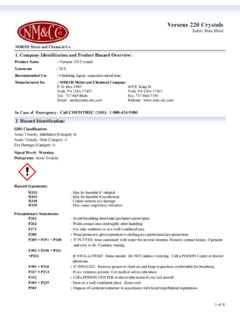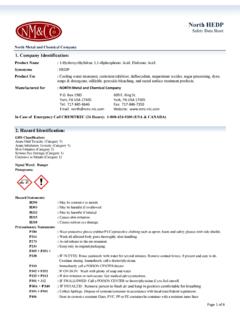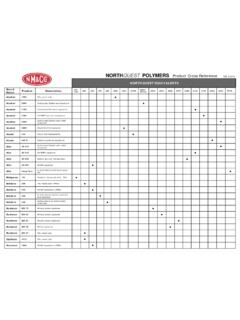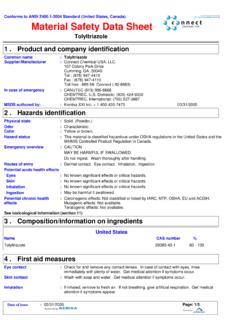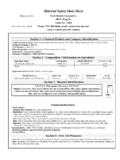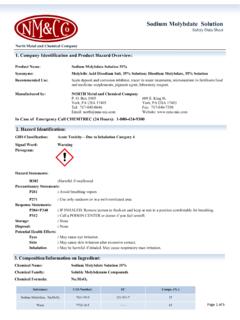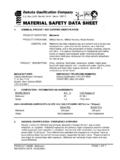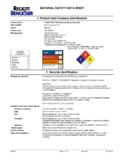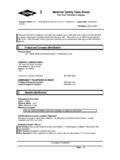Transcription of 1. Company Identification and Product Hazard Overview
1 1 of 6 NORTH Metal and Chemical Co. Sodium Benzotriazole 40% Liquid Safety Data Sheet 1. Company Identification and Product Hazard Overview : Product Name : Sodium Benzotriazole 40% Synonyms : BTA-Na; 1H-Benzotriazole Sodium Salt; Sodium Benzo Triazole; Sodiumbenzotriazolate Recommended Use : Corrosion Inhibitor in water treatment programs. Manufactured for : NORTH Metal and Chemical Company P. O. Box 1985 609 E. King St. York, PA USA 17405 York, PA USA 17403 Tel: 717-845-8646 Fax: 717-846-7350 Email: Website: In Case of Emergency: Call CHEMTREC (24H): 1-800-424-9300 2. Hazard Identification : GHS Classification: Skin Corrosion (Category 1B) Eye Damage (Category 1) Acute Oral Toxicity (Category 4) Signal Word: DANGER Pictogram: Corrosive Hazard Statements: H302 : Harmful if swallowed H314 : Causes severe skin burns and serious eye damage.
2 H318 : Causes serious eye damage Precautionary Statements: Prevention: P270 : Do not eat, drink, or smoke when using this Product P280 : Wear protective gloves/protective clothing/eye protection/face protection. P303 + P353 +P363 : If on skin or hair: rinse skin with water/shower. Wash contaminated clothing before reuse P305 + P351 + P338 : If in eyes: rinse cautiously with water for several minutes. Remove contact lenses, if present and easy to do. Continue rinsing. P310 : Immediately call a doctor or physician if serious eye and skin damage develops. Response & Storage: P303 + P361 +P353 : IF ON SKIN (or hair): Take off immediately all contaminated clothing. Rinse skin with water/shower. P363 : Wash contaminated clothing before reuse. P305 + P351 + P338 : IF IN EYES: Rinse cautiously with water for several minutes. Remove contact lenses, if present and easy to do.
3 Continue rinsing. P301 + 312 : IF SWALLOWED: Call a POISON CENTER or doctor/physician if you feel unwell. P321 : Immediately call a doctor if you feel unwell. P273 : Avoid release to the environment. P501 : Dispose of contents/container in accordance with local/state/federal regulations. 2 of 6 3. Composition/Information on Ingredient: Chemical Name : Sodium Benzotriazole 40%, BTA-Na, 1H-Benzotriazole Sodium Salt (1:1) Chemical Family : Azoles. Chemical Formula : C6H4N3Na Substance: CAS Number: EC Compo. (% ) Sodium Benzotriazole 15217-42-2 239-269-6 39 - 41 % Water 7732-18-5 59 - 61 % 4. First Aid Measures: Eyes : Flush skin with running water for at least fifteen minutes. Remove any contact lenses. Get medical aid/ attention immediately. Skin : Remove contaminated clothing. Wash skin with plenty of running water and soap. Get medical attention/ aid if irritation persists.
4 Contaminated clothing should be thoroughly washed before reuse. Ingestion : If the Product is swallowed, first rinse mouth. Give small amount of water to drink. Call doctor/ physician/poison center immediately. Do not induce vomiting. Never give anything by mouth to an unconscious person. If a person vomits, place him/her in recovery position so the vomit does not enter lungs. Inhalation : If safe to do so, remove individual from further exposure. Keep warm and at rest. If breathing has ceased, give artificial respiration. Do not give mouth to mouth resuscitation. Get medical attention/ consult a physician immediately. Note to Physician : Treat symptomatically. PPE for first responders : Gloves and safety goggles are highly recommended. 5. Fire Fighting Measures: Flash Point ( C) : Above 100 C. Flammable Limits : Not available. Autoignition Temp. : Not available.
5 Flammable Class : Not available. Flame Propagation or Burning Rate of Solids : Not available. General Hazard : Evacuate personnel downwind in-order to avoid inhalation of irritating and/or harmful fumes and smoke. Extinguishing Media : Water spray, chemical-type foam. Appropriate for the surrounding area. Hazardous Combustion Products : Carbon monoxide, carbon dioxide, nitrogen oxides. Fire Fighting Procedures : Hazardous decomposition and combustion products such as carbon/nitrogen oxides can be formed if Product is burning. Cool exposed containers with water spray to prevent over heating. Fire Fighting Equipment : Respiratory and eye protection are required for fire fighting personnel. Full protective equipment (bunker gear) and self-contained breathing apparatus (SCBA) should be used for all indoor fires and any significant outdoor fires.
6 Evacuate area and fight fire from safe distance or a protected location. Move fire-exposed containers, if allowable without sacrificing the safety of the firefighters. If possible, firefighters should control run-off water to prevent environmental contamination. Sensitivity to Static Discharge : Not sensitive. Sensitivity to Mechanical Impact : Not sensitive. Safety Data Sheet Sodium Benzotriazole 40% 3 of 6 6. Accidental Release Measures: Protective Gear for Personnel: For Small Spill : Safety glasses or chemical splash goggles, chemically resistant gloves (rubber/latex), chemically resistant boots, and any appropriate body protection to minimize direct contact to the skin. For Large Spill : Triple gloves (rubber and nitrile over latex), chemical resistant suit, boots, hard hat, full face mask/an air purifying respirator (NIOSH approved).
7 Self contained breathing apparatus must be worn in situations where fumigant gas generation and low oxygen levels are a consequence of contamination from the leak. Spill Clean-up Procedures: For Small Spill : In the event of a small spill, the leak should be contained with an absorbent pad and placed in a properly labeled waste disposal container immediately. Clean the spill area with water. Do not let chemical/waste enter the environment For Large Spill : In the event of a large spill, contain the spill immediately and dispose according to state, federal, and local hazardous waste regulation. Do not let chemical/waste enter the environment. Environmental Precaution : Water spill: use appropriate containment to avoid run off or release to sewer or other waterways. Land spill: use appropriate containment to avoid run off or release to ground. General precaution: remove containers of strong acid and alkali from the release area.
8 Release Notes : If spill could potentially enter any waterway, including intermittent dry creeks, contact local authorities. 7. Handling and Storage: Handling : Use appropriate personal protective equipment as specified in Section 8. Handle in a well-ventilated area. Handle in a manner consistent with good industrial/manufacturing techniques and practices. Wash hands thoroughly with soap and water after use. Remove contaminated clothing and protective equipment before entering eating areas. Storage : Store in a cool, dry well-ventilated area. Keep containers closed when not in use. Keep Product isolated from incompatible materials/conditions. 8. Exposure Controls and Personal Protection: Engineering Controls : Use appropriate engineering controls to minimize exposure to vapors generated via routine use. Maintain adequate ventilation of workplace and storage areas.
9 Personal Protective Equipment : Eyes and face: Wear safety glasses with side shields or goggles when handling this material. Skin: Avoid direct contact with skin. Wear rubber gloves, apron, boots or whole bodysuit when handling this Product . Respiratory: Avoid breathing vapor or mist. Use NIOSH approved respiratory protection equipment if airborne exposure is excessive. If used, full face-piece replaces the need for face shield and/or chemical goggles. Consult the respirator manufacturer to determine the appropriate type of equipment for a given application. Work Hygienic Practices : Facilities storing or using this material should be equipped with emergency eyewash, and a safety shower. Good personal hygiene practices should always be followed. Exposure Limits: Substance: CAS No.: OSHA STEL ACGIH TLV OSHA PEL ACGIH STEL Sodium Benzotriazole 40% Liquid 15217-42-2 N/A N/A N/A N/A Safety Data Sheet Sodium Benzotriazole 40% 4 of 6 9.
10 Chemical and Physical Properties: Appearance : Liquid Odor : Characteristic Odor threshold : Not available Color : Colorless to Pale Yellow pH (10% Soln.) : - Melting Point : Not available Freezing Point : -5 C to -10 C Boiling Range : Not available Flash Point : > 195 C Viscosity (cPs) @ 25 C : Not applicable Decomposition Temp. : Not available Evaporation Rate : Not available Lower Explosive Limit : Not available Upper Explosive Limit : Not available Vapor Pressure : Not available Vapor Density : Not available Specific Gravity : - Solubility : Soluble in water Partition Coefficient : Not available Auto Ignition Temp. : Not available 10. Stability and Reactivity: Stability : The Product is stable under normal ambient conditions of temperature and pressure. Polymerization : Polymerization will not occur. Hazardous Decomposition Products : Carbon and nitrogen oxides.
